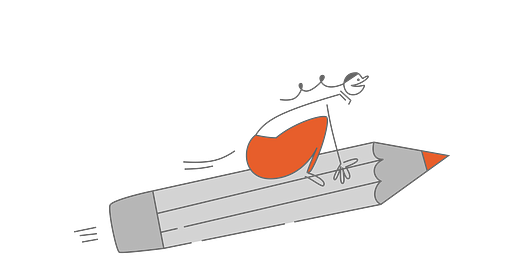Building blocks of a product designer's career
The six high-level design dimensions: Product Thinking, Interaction Design, Visual Design, Intentionality, Drive, and Self-awareness.

In previous articles, I've described the jobs of a product designer. These are the core building elements of the product design career ladder, and they are the skills of every product designer. They are shared by all of us, regardless of level. But besides the hard skills, these design jobs include soft skills.
Hard skills refer to the practical knowledge and techniques acquired through design school or work experience, which are essential in design tasks. These skills involve using design tools, software, and other tangible resources like pencils and paper. If it's a skill you can physically execute, it falls under hard skills.
On the other hand, soft skills are less concrete and require more effort to develop. They involve your personality traits, ability to interact with others, and work principles. Your life experiences are crucial in cultivating these skills and enhancing emotional intelligence and self-awareness.
Product Thinking, Interaction Design, Visual Design, Intentionality, Drive, and Self-awareness are the high-level design dimensions I learned from my experience and mentors. Understanding that these six dimensions combine your hard and soft skills is critical. So let's get into each design dimension now.
Product Thinking
Product thinking skills include designing effective products by solving user and business problems. There are three sub-categories within this dimension:
User: A skill to comprehend the needs and challenges of product users.
Business: A skill to identify business opportunities and generate revenue by solving user problems.
Strategy: A skill to strategically design and launch products to achieve product-market fit.
Interaction Design
Interaction design skills include how to design for people and their actions. Within this dimension, there are three main sub-categories:
Patterns: Understanding user behavior patterns is crucial for designing practical solutions for a product platform
Systems: Knowing how design patterns fit into a more extensive system is also important
Prototyping: Creating prototypes, whether static or functional, is critical for testing and implementation
Visual Design
Visual design skills include building visually appealing user interfaces while adhering to branding and style guidelines. Visual design is divided into four distinct sub-categories:
Layout & Hierarchy: Organize UI elements in a clear and understandable way
Typography & Iconography: Use typography and icons effectively
Color: Utilize color to convey meaning
Motion: Animate UI elements in ways that users can easily comprehend
Intentionality
Intentionality skills include addressing challenges while working with people on purpose. Within this dimension, there are three main sub-categories:
Process: Use proven design techniques to create reliable solutions
Communication: Communicate your work in a way that others can understand
Collaboration: Build trust and collaborate well with colleagues from different areas of the company
Drive
Drive skills include a designer's enthusiasm for the profession of design as well as their readiness to lead others. Within this dimension, there are three main sub-categories:
Leadership: Take ownership of a problem and become an expert in that area
Feedback: Develop the skill of giving and receiving constructive feedback
Community: Learn to teach others and contribute to the design community
Self-Awareness
Finally, Self-Awareness skills include the ability to understand oneself and how to improve. This dimension is divided into three main sub-categories:
Strengths: A skill to understand one's strengths and how to promote them.
Weaknesses: A skill to understand one's weaknesses and how to improve them.
Growth: A skill to continually seek new ways to improve as a designer.
Product Designer, don't be overwhelmed!
The six design axes and the numerous skills inside each dimension may overwhelm you.
"How could one designer be proficient in all 19 skills!"
The simple explanation is, you shouldn't be strong in every skill. Accept that you will be strong in some of these skills and weak in others, making your skill set unique. Because of this, you should never use design dimensions as a checklist.
While we all have these skills, we do not all have the same proficiency level, which is what differentiates us. Some people are learning a skill, while others are pretty good at it. Because of our differences, it is even more necessary for us to support one another. Recognizing our distinct abilities will help create a stronger, more inclusive design community.
Oh! Furthermore, not every design skill suits one of the six design dimensions well. As a result, it is an insufficient framework for explaining the ladder for all product design disciplines.
Not to mention that the design is constantly changing, with new skill requirements developing every day in upcoming technologies such as Web 3.0, Metaverse, VR, and Wearables.
So, while the design dimensions will remain constant, you can be confident that skills will change in tandem with the industry, as should your skills as a product designer. But that's a topic for another day.


